Leading-tone
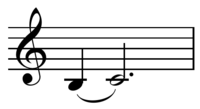
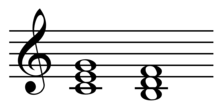
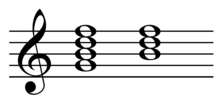
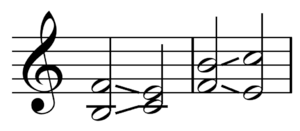

 |
Leading tone in V-I progression
Leading tone repeats four times over dominant (V) chord which then moves to the tonic (I) as the leading tone resolves upwards to the tonic |
| Problems playing this file? See media help. | |


In music theory, a leading-note (also subsemitone, and called the leading-tone in the US) is a note or pitch which resolves or "leads" to a note one semitone higher or lower, being a lower and upper leading-tone, respectively.
More narrowly, the leading tone is the seventh scale degree of the major scale, with a strong affinity for and leading melodically to the tonic (Benward and Saker 2003, 203). It is sung as ti in movable-do solfège. For example, in the C major scale (white keys on a piano, starting on C), the leading note is the note B; and the leading note chord uses the notes B, D, and F: a diminished triad. In music theory, the leading note triad is symbolized by the Roman numeral vii°. By contrast, an upper leading-tone (Berger 1987, 148; Coker 1991, 50), which leads down, may be found as the seventh of the dominant seventh chord, which leads to the third of the tonic chord (in C: F of a G7 chord leads to E of a CM chord). The upper leading-tone may also be found above the tonic, on D♭ in C.
Tonality
According to Ernst Kurth (1913, 119–736) the major and minor thirds contain "latent" tendencies towards the perfect fourth and whole-tone, respectively, and thus establish tonality. However, Carl Dahlhaus (1990, 44–47) contests Kurth's position, holding that this drive is in fact created through or with harmonic function, a root progression in another voice by a whole-tone or fifth, or melodically (monophonically) by the context of the scale. For example, the leading note of alternating C chord and F minor chords is either the note E leading to F, if F is tonic, or A♭ leading to G, if C is tonic. In works from the 14th- and 15th-century Western tradition, the leading-note is created by the progression from imperfect to perfect consonances, such as a major third to a perfect fifth or minor third to a unison. The same pitch outside of the imperfect consonance is not a leading note.
The leading-tone seventh chords are viiø7 in major and viio7 in minor (Benward and Saker 2003, 219).
As a diatonic function the leading-note is the seventh scale degree of any diatonic scale when the distance between it and the tonic is a single semitone. In diatonic scales where there is a whole tone between the seventh scale degree and the tonic, such as the Mixolydian mode, the seventh degree is called, instead, the subtonic.
Chord
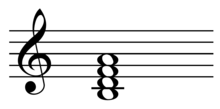
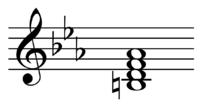
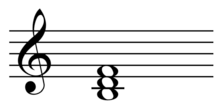
In music theory, a leading-tone chord is a triad built on the seventh scale-degree in major and the raised seventh-scale-degree in minor (the leading-tone). The quality of the leading-tone triad is diminished in both major and minor keys.
Voice-leading
Since the leading-tone triad is diminished, it is rarely found in root position. Instead, it is commonly found in first inversion. In a four-part chorale texture, the third of the leading-tone triad is doubled in order to avoid adding emphasis to the tritone created by the root and the fifth. Unlike a dominant where the leading-tone can be frustrated and not resolve to the tonic if it is in an inner voice, the leading-tone in a leading-tone triad must resolve to the tonic. Commonly the fifth of the triad resolves down since it is phenomenologically similar to the seventh in a dominant seventh chord.
On the other hand, the leading-tone seventh chord does appear in root position. For this reason, outside of the two uses listed below, a leading-tone triad is less common than a leading-tone seventh chord.
Uses
The leading-tone triad is used in several functions. Commonly, it is used as a passing chord between a root position tonic triad and a first inversion tonic triad (Aldwell, Schachter, and Cadwallader 2010, 138). The leading-tone triad prolongs tonic through neighbor and passing motion in this instance.
The leading-tone triad may also be regarded as an incomplete dominant seventh chord: "A chord is called 'incomplete' when its root is omitted. This omission occurs, occasionally, in the chord of the dom.-seventh, and the result is a triad upon the leading-tone" (Goetschius 1917, 72, §162–63, 165). Since it contains three common tones with a dominant seventh chord, it easily can replace and function as a dominant. When used at a cadence point, it creates an imperfect authentic cadence since there is no root motion from scale-degree 5 to scale-degree 1 in the bass. This type of cadence was used commonly in the Renaissance era but increasingly grew out of fashion as the common practice period progressed.
See also
Sources
- Aldwell, Edward, Carl Schachter, and Allen Cadwallader (2010). Harmony and Voice-Leading, fourth edition. New York: Schirmer/Cengage Learning. ISBN 9780495189756
- Benward, Bruce, and Marilyn Nadine Saker (2003). Music: In Theory and Practice, Vol. I, seventh edition. Boston: McGraw-Hill. ISBN 978-0-07-294262-0.
- Berger, Karol (1987). Musica Ficta: Theories of Accidental Inflections in Vocal Polyphony from Marchetto da Padova to Gioseffo Zarlino. Cambridge and New York: Cambridge University Press. ISBN 0-521-32871-3 (cloth); ISBN 0-521-54338-X (pbk).
- Coker, Jerry (1991). Elements of the Jazz Language for the Developing Improvisor. Miami, Fla.: CCP/Belwin, Inc. ISBN 1-57623-875-X.
- Dahlhaus, Carl (1990). Studies on the Origin of Harmonic Tonality, trans. Robert O. Gjerdingen. Princeton: Princeton University Press. ISBN 0-691-09135-8.
- Goetschius, Percy (1917). The Theory and Practice of Tone-Relations: An Elementary Course of Harmony, 21st edition. New York: G. Schirmer.
- Kurth, Ernst (1913). Die Voraussetzungen der theoretischen Harmonik und der tonalen Darstellungssysteme. Bern: Akademische Buchhandlung M. Drechsel. Unaltered reprint edition, with an afterword by Carl DahlhausMunich: E. Katzbichler, 1973. ISBN 3-87397-014-7.
- Stainer, John, and William Alexander Barrett (eds.) (1876). A Dictionary of Musical Terms. London: Novello, Ewer and Co. New and revised edition, London: Novello & Co, 1898.